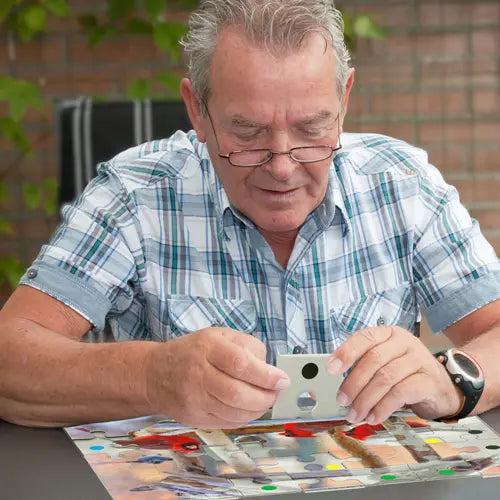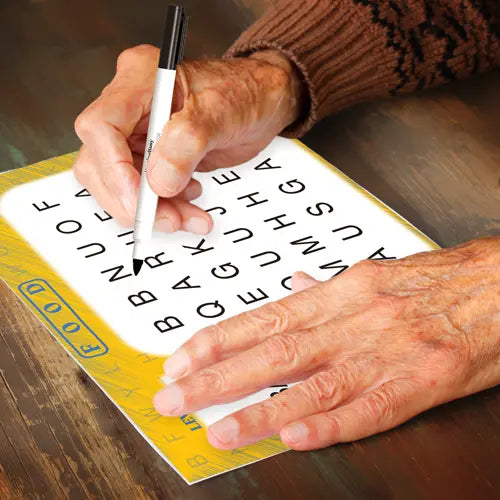
In 2008 a group of researchers presented a workshop titled “Beyond Bingo and Painted Nails: Meaningful Activity for Persons with Dementia” at the American Association for Geriatric Psychiatry Annual Conference. The somewhat cynical title was chosen to suggest that the all too common activities of playing bingo and painting residents’ fingernails was perhaps not the most effective way to engage residents with dementia or Alzheimer’s.
The article makes the case that residents in long term care facilities need to be offered activities that, as we say in the DementiAbility workshop, meet their individual needs, interests, skills and abilities. But does that mean that we have to throw the baby out with the bathwater? Does it mean that bingo doesn’t belong in long term care facilities? We don’t think so. Does bingo have to be a large group program reminiscent of a smoke-filled bingo hall? Definitely not.
When bingo is offered in a large group setting there are many potential barriers that prevent a resident with de mentia or alzheimer s from achieving two primary objectives: success and independence. Some of the barriers that apply to all residents include visual and/or hearing impairment, dexterity issues, and reaction time. People with dementia may also have difficulties in complex attention and executive function related to their dementia. If we instead offer a modified bingo activity, those bingo enthusiasts can be offered a program that is tailored to their needs.
The fun in playing bingo is the challenge of finding the numbers on the card and the excitement of yelling “BINGO!”. Winning prizes is not the goal, nor is it a benefit and they should not be offered - winning or losing is not the purpose. Rather, the objective is the cognitive stimulation of finding the selected number or item; the motion of picking up the markers and placing them on the card; the opportunity to discuss the items or topics with picture bingo and word bingo.
Easy Number Bingo
Because dementia and Alzheimer's participants are so conditioned to getting a prize, you’ll likely have some who ask for it. The answer is that this bingo doesn’t have a prize - the prize in this activity is the fun of the game and challenge of figuring out the answer.
We can offer a fun bingo activity that is achievable for people with dementia. The first thing we can do is simplify the game. Rather than using a full sized bingo card with 5 rows and 5 columns of numbers ranging from 1 to 75, we can use a 3 x 3 card with numbers 1 to 29 (such as our Easy Number Bingo). But who says that we have to use numbers at all?
Animal Picture Bingo
An easier dementia care game is to use pictures – the cards have pictures in the 3 x 3 grid (of animals, for example) and the caller holds up a card with a picture on it while announcing the name of the animal (such as our Animal Picture Bingo). Other ideas include
- Tools
- Flowers
- Instruments
- Household items
- Themed for special occasions such as our free "Back to School Picture Bingo" or Valentine’s Day, Halloween, Christmas, etc.
A game with a little more challenge is to have words on the card that complete a phrase that the caller reads (such as Expressions Bingo). Other ideas include
- Our free "St. Patrick's Day Word Bingo"
- Answers to a trivia question
- Show the picture from picture bingo above, identify the name of item and look for that word on the bingo card
- Play a sound associated with the item, identify the name of item and look for that word on the bingo card
All the variations have their place depending on the skills and abilities of the participants.
It is important to choose a small group of participants who have similar abilities and to pace the activity so that everyone can participate and do more on their own, without help. Make it a comfortable routine by setting a regular schedule for the activity. This allows you to assign roles to the participants which allows them to make a contribution and increases their self-esteem. Roles include such things as
- Distribute the cards and/or markers
- Be the “caller”
- Collect the cards and/or markers
- Ensure that all the pieces of the game are put away
- Sort the bingo markers by color
To add more variety to the activity
- Offer each participant their choice of card (or which side of the card they would like to use)
- Offer them their choice of color of bingo marker
- Have them count their bingo markers to ensure that they have enough
With a little thought and preparation, we can go beyond bingo and then back again, making it an excellent small group alzheimer care activity. Download our Bingo Program Sheet for more information on presenting simplified bingo activities.




